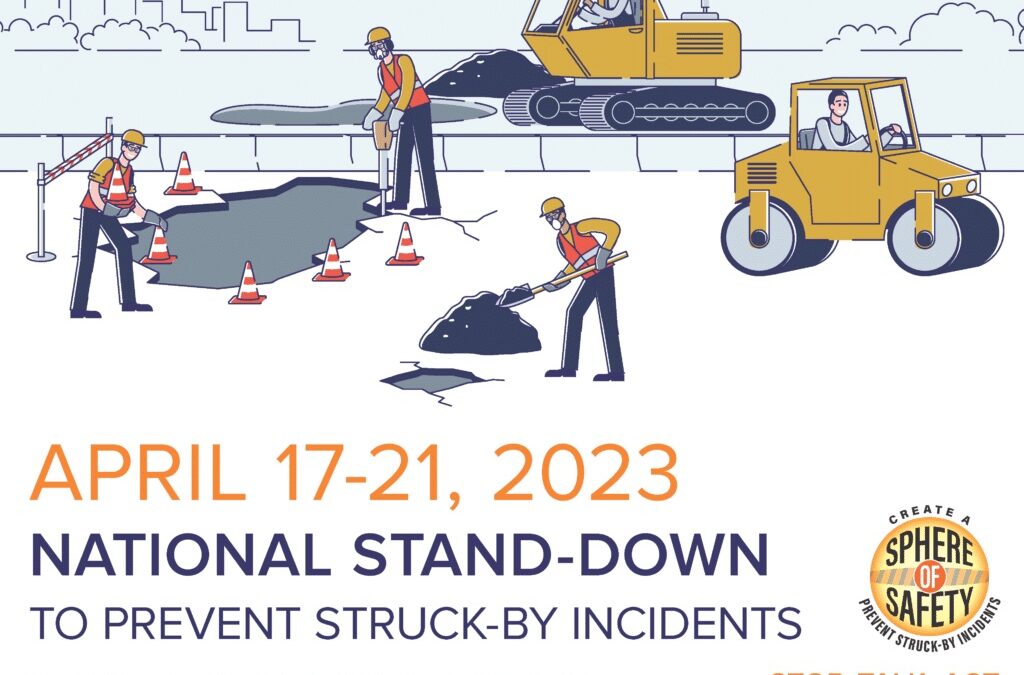Struck-by incidents are the second leading cause of workplace deaths and the leading cause of nonfatal injuries among construction workers [1]. In 2019, there were 170 construction worker deaths and approximately 16,600 nonfatal construction injuries from struck-by incidents. Addressing this persistent issue is paramount to ensure the safety and well-being of construction workers, and that’s what the National Stand-Down attempts to do.
This article explains the importance of joining the National Stand-Down to prevent struck-by incidents and the role of innovative safety measures and technological advancements in mitigating the risk of struck-by incidents.
What is The National Stand-Down to Prevent Struck-By Incidents?
The National Stand-Down to Prevent Struck-by Incidents, in coordination with National Work Zone Awareness Week, is a voluntary event for employers to talk directly to employees about safety. Any workplace can hold a stand-down by taking a break to focus on “Struck-by Hazards” and reinforcing the importance of training and prevention.
Construction workers face many challenges and threats to their safety and health, including being struck by an object or piece of equipment. Struck-by incidents include:
- accidents involving vehicles and transportation equipment.
- falling tools or objects, flying and discharged objects; and
- non-transportation vehicles or equipment, such as swing hazards from cranes.
Many of these incidents are preventable and could be avoided through a better understanding of the hazards, improved planning and scheduling, implementation of interventions, and increased training. Continuing efforts are needed to address hazards in construction workplaces.
CPWR provides many resources to use in support of this initiative: Resources
Safety Measures You Can Take to Prevent Struck-By Incidents
While the National Safety Stand-Down is important for raising awareness and providing tools to educate employees, it is just one piece to preventing incidents. There are other measures safety leaders can take, such as modernizing safety performance. Assessments, workflows, and safety observations can also play a critical role in prevention. In addition, by moving away from digital forms and instead, using modern dynamic, logic-based workflow software, companies can streamline these processes, improve compliance, and identify and address struck-by incidents more effectively.
Assessments
Job Safety Assessments (JSA)
is a process that breaks down a job into its component steps, identifies hazards, and determines the best way to perform the job safely. This process can help employers identify struck-by hazards and develop strategies for preventing them.
Software streamlines the JSA process by providing a platform for creating, distributing, and tracking JSAs. This ensures that all workers have access to up-to-date JSAs and standardizes these processes across the organization.
Workflows
Establishing a process for those who work with construction vehicles and creating workflows are other tools employers can use to prevent incidents. Workflows require frontline workers to follow a predetermined set of safety protocols when working with heavy machinery. By requiring workers to follow established safety protocols, employers can reduce the risk of incidents.
Software can facilitate the workflow process by providing a centralized platform for creating and managing step-by-step safety processes, tracking compliance, and requiring photo and videos of work environments. By using software for workflows, companies can ensure that workers follow established safety protocols, reducing the risk of struck-by incidents.
Safety Observations
Safety observations are an essential tool for preventing workplace accidents. Safety observations involve monitoring the workplace/zone for hazards and identifying areas for improvement. This process can help employers identify hazards and develop strategies for preventing them from occurring.
Software can streamline the safety observation process by providing a platform for conducting and documenting observations, tracking actions taken to address hazards, and generating reports on safety performance. By using software for safety observations, companies can take corrective action, and monitor the effectiveness of their incident prevention strategies.
How Anvl Can Help
Struck-by Prevention is an ongoing process that requires a combination of strategies. While participating in the National Stand-Down is an essential step toward raising awareness of struck-by incidents, it’s crucial to remember that more work is needed to ensure workplace safety.
Anvl’s Connected Worker Software can help by centralizing and simplifying key aspects of EHS. It organizes the data collected during inspections, analyzes it to identify trends, and allows companies to track corrective action plans from start to finish, so leaders can hold management accountable.
Anvl gives leaders real-time insight into their inspection and action item data across their entire organization, helping them make strategic choices that create genuine change. Easy-to-use mobile apps and digital workflows keep everything in one place and give frontline workers easy, offline access out in the field. This means companies catch issues faster, enhance communication, and identify improvements that move the organization toward its goals.
Contact us today to find out how Anvl can help your business create a safer, more compliant workplace.
Additional Resources:


